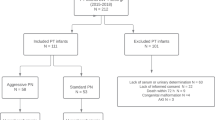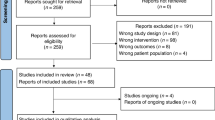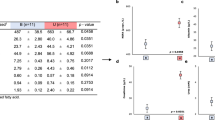Abstract
Greater protein intakes are required than have been commonly used to achieve fetal in utero protein accretion rates in preterm neonates. To study the efficacy and safety of more aggressive amino acid intake, we performed a prospective randomized study in 28 infants [mean wt, 946 ± 40 g (SEM)] of 1 (low amino acid intake, LAA) versus 3 g·kg−1·d−1 (high amino acid intake, HAA) at 52.0 ± 3.0 h of life. After a minimum of 12 h of parenteral nutrition, efficacy was determined by protein balance and was significantly lower in the LAA versus HAA groups by both nitrogen balance (−0.26 ± 0.11 versus 1.16 ± 0.15 g·kg−1·d−1, p < 0.00005) and leucine stable isotope (0.184 ± 0.17 versus 1.63 ± 0.20 g·kg−1·d−1, p < 0.0005) methods. Leucine flux and oxidation and nonoxidative leucine disposal rates were all significantly higher in the HAA versus LAA groups (249 ± 13 versus 164 ± 8, 69 ± 5 versus 32 ± 3, and 180 ± 10 versus 132 ± 8 μmol·kg−1·h−1, respectively, p < 0.005), but leucine appearance from protein breakdown was not (140 ± 15 in HAA versus 128 ± 8 μmol·kg−1·h−1). In terms of possible toxicity with HAA, there were no significant differences between groups in the amount of sodium bicarbonate administered, degree of acidosis as determined by base deficit, or blood urea nitrogen concentration. Parenteral HAA versus LAA intake resulted in increased protein accretion, primarily by increasing protein synthesis versus suppressing protein breakdown, and appeared to be well tolerated by very preterm infants in the first days of life.
Similar content being viewed by others
Log in or create a free account to read this content
Gain free access to this article, as well as selected content from this journal and more on nature.com
or
Abbreviations
- PN:
-
parenteral nutrition
- LAA:
-
low amino acid intake
- HAA:
-
high amino acid intake
- Intleuc:
-
leucine intake rate
- Qleuc:
-
leucine flux rate
- Oxleuc:
-
leucine oxidation rate
- NODleuc:
-
nonoxidative leucine disposal intake rate
- RPleuc:
-
rate of leucine appearance from protein breakdown
- ELBW:
-
extremely low birth weight
- BUN:
-
blood urea nitrogen
- GCMS:
-
gas chromatography-mass spectroscopy
References
American Academy of Pediatrics Committee on Nutrition 1998 Nutritional needs of preterm infants. In: Kleinman R (ed) Pediatric Nutrition Handbook. American Academy of Pediatrics, Elk Grove Village, IL, pp 55–87.
Ziegler E 1991 Malnutrition in the premature infant. Acta Paediatr Scand Suppl 374: 58–66
Lucas A 1995 Nutrition, growth and development of postdischarge, preterm infants. In: Hay Jr WW, Lucas A (eds) Posthospital Nutrition in the Preterm Infant. Ross Laboratories, Columbus, OH, pp 81–89.
Ehrenkranz R, Younes N, Lemons J, Fanaroff AA, Donovan EF, Wright LL, Katsikiotis V, Tyson JE, Oh W, Shankaran S, Bauer CR, Korones SB, Stoll BJ, Stevenson DK, Papile LA 1999 Longitudinal growth of hospitalized very low birthweight infants. Pediatrics 104: 280–289
Micheli JL, Schutz Y 1993 Protein. In: Tsang RC, Lucas A, Uauy R, Zlotkin S (eds) Nutritional Needs of the Preterm Infant, Scientific Basis and Practical Guidelines. Caduceus Medical Publishers, Inc, Pawling, NY, pp 29–46.
Hay WW Jr 1991 Nutritional requirements of the extremely-low-birth-weight infant. In: Hay Jr WW (ed) Neonatal Nutrition and Metabolism. Mosby-Year Book, St. Louis, pp 361–391.
Lucas A, Morley R, Cole TJ 1998 Randomised trial of early diet in preterm babies and later intelligence quotient. BMJ 317: 1481–1487
Rubecz I, Mestyan J, Varga P, Klujber L 1981 Energy metabolism, substrate utilization, and nitrogen balance in parenterally fed postoperative neonates and infants. J Pediatr 98: 42–46
Zlotkin SH, Bryan MH, Anderson GH 1981 Intravenous nitrogen and energy intakes required to duplicate in utero nitrogen accretion in prematurely born human infants. J Pediatr 99: 115–120
Duffy B, Gunn J, Collinge J, Pencharz P 1981 The effect of varying protein quality and energy intake on the nitrogen metabolism of parenterally fed very low birthweight (<1600 g) infants. Pediatr Res 15: 1040–1044
van Toledo-Eppinga L, Kalhan SC, Kulik W, Jakobs C, LaFeber HN 1996 Relative kinetics of phenylalanine and leucine in low birth weight infants during nutrient administration. Pediatr Res 40: 41–46
Anderson TL, Muttart CR, Bieber MA, Nicholson JF, Heird WC 1979 A controlled trial of glucose versus glucose and amino acids in premature infants. J Pediatr 94: 947–951
Yu VYH, James B, Hendry P, MacMahon RA 1979 Total parenteral nutrition in very low birthweight infants: a controlled trial. Arch Dis Child 54: 653–661
Saini J, MacMahon P, Morgan JB, Kovar IZ 1989 Early parenteral feeding of amino acids. Arch Dis Child 64: 1362–1366
van Lingen RA, van Goudoever JB, Luijendijk IH, Wattimena JL, Sauer PJ 1992 Effects of early amino acid administration during total parenteral nutrition on protein metabolism in pre-term infants. Clin Sci 82: 199–203
Rivera A, Bell EF, Bier DM 1993 Effect of intravenous amino acids on protein metabolism of preterm infants during the first three days of life. Pediatr Res 33: 106–111
Kashyap S, Heird WC 1993 Protein requirements of low birthweight, very low birthweight, and small for gestational age infants. In: Raiha NCR (ed) Protein Metabolism During Infancy. Raven Press, New York, pp 133–151.
van Goudoever JB, Sulkers EJ, Halliday D, Degenhart HJ, Carnielli VP, Wattimena JL 1995 Whole body protein turnover in preterm appropriate for gestational age and small for gestational age infants: comparison of [15N]glycine and [1-13C]leucine administered simultaneously. Pediatr Res 37: 381–388
Thureen PJ, Anderson AH, Baron KA, Melara DL, Hay WW, Fennessey PV 1998 Protein balance in the first week of life in ventilated neonates receiving parenteral nutrition. Am J Clin Nutr 68: 1228–1136
Thureen PJ, Phillips RE, DeMarie MP, Hoffenberg A, Bronstein MN, Spedale SB, Hay WW 1997 Technical and methodologic considerations for performance of indirect calorimetry in ventilated and nonventilated preterm infants. Crit Care Med 25: 171–179
Richardson DK, Gray JE, McCormick MC, Workman K, Goldmann DA 1993 Score for neonatal acute physiology: a physiologic severity index for neonatal intensive care. Pediatrics 91: 617–623
Gray JE, Richardson DK, McCormick MC, Workman-Daniels K, Goldmann DA 1992 Neonatal therapeutic intervention scoring system: a therapy-based severity-of-illness index. Pediatrics 90: 561–567
Loy GL, Quick AN, Teng CC, Hay WW, Fennessey PV 1990 Versatile stable isotope technique for the measurement of amino acids and keto acids: comparison with radioactive isotopes and its use in measuring in vivo disposal rates. Anal Biochem 185: 1–9
Denne SC, Kalhan SC 1986 Glucose carbon recycling and oxidation in human newborns. Am J Physiol 251: E71–E77
Pineault M, Maag U, Chessex P 1990 Reliability of the twenty-four-hour nitrogen balance in parenterally fed newborn infants. J Parenter Enter Nutr 14: 53–55
Lopez AM, Wolfsdorf J, Raszynski A, Contijoch-Serrano V 1986 Estimation of nitrogen balance based on a 6-hour urine collection in infants. J Parenter Enter Nutr 10: 517–518
Matthews DE, Motil KJ, Rohrbaugh DK, Burke JF, Young VR, Bier DM 1980 Measurement of leucine metabolism in man from a primed continuous infusion ofl-[1-13C]leucine. Am J Physiol 238: E473–E479
Van Aerde JEE, Sauer PJJ, Pencharz PB, Canagarayar U, Beesley J, Smith JM, Swyer PR 1985 The effect of energy intake and expenditure on the recovery of 13CO2 in the neonate during 4-hour primed constant infusion of Na13CO3 . Pediatr Res 19: 806–810
Allsop JR, Wolfe RR, Burke JF 1978 Tracer priming of the bicarbonate pool. J Appl Physiol 45: 137–139
Waterlow J, Garlick P, Millward D 1978 Total protein turnover from measurements on plasma and on the whole body. In: Waterlow J, Garlick P, Millward D (eds) Protein Turnover in Mammalian Tissues and in the Whole Body. Elsevier/North-Holland Biomedical Press, Amsterdam, pp 301–325.
Ziegler EE 1986 Protein requirements of preterm infants. In: Fomon SJ, Heird WC (eds) Energy and Protein Needs During Infancy. Academic Press, New York, pp 69–85.
Ziegler EE 1994 Protein in premature feeding. Nutrition 10: 69–71
Battista MA, Price PT, Kalhan SC 1996 Effect of parenteral amino acids on leucine and urea kinetics in preterm infants. J Pediatr 128: 130–134
van Goudoever JB, Colen T, Wattimena JLD, Huijmans JGM, Carnielli VP, Sauer PJJ 1995 Immediate commencement of amino acid supplementation in preterm infants: effect on serum amino acid concentrations and protein kinetics on the first day of life. J Pediatr 127: 458–465
Denne SC, Rossi EM, Kalhan SC 1991 Leucine kinetics during feeding in normal newborns. Pediatr Res 30: 23–27
Fiorotto M, Burrin D, Perez M, Peeds P 1991 Intake and use of milk nutrients by rat pups suckled in small, medium, or large litters. Am J Physiol 260: R1104–R1113
Davis T, Burrin D, Fiorotto M, Nguyen H 1996 Protein synthesis in skeletal muscle and jejunum is more responsive to feeding in 7- than in 26-day old pigs. Am J Physiol 270: E802–E809
Motil KJ, Matthews DE, Bier DM, Burke JF, Munro HN, Young VR 1981 Whole-body leucine and lysine metabolism: response to dietary protein intake in young men. Am J Physiol 240: E712–E721
Melville S, McNurlan MA, McHardy KC, Broom J, Milne E, Calder AG, Garlick PJ 1989 The role of degradation in the acute control of protein balance in adult man: failure of feeding to stimulate protein synthesis as assessed byl-[1-13C]leucine infusion. Metabolism 38: 248–255
Castellino P, Luzi L, Simonson D, Haymond M, DeFronzo R 1987 Effect of insulin and plasma amino acid concentrations on leucine metabolism in man. J Clin Invest 80: 1784–1793
Flakoll P, Kulaylat M, Frexes-Steed M, Hourani H, Brown LL, Hill JO, Abumrad NN 1989 Amino acids augment insulin's suppression of whole body proteolysis. Am J Physiol 257: E839–E847
Rennie MJ, Edwards RHT, Halliday D, Matthews DE, Wolman SL, Millward DJ 1982 Muscle protein synthesis measured by stable isotope techniques in man: the effect of feeding and fasting. Clin Sci 63: 519–523
Hoffer LJ, Yang RD, Matthews DE, Bistrian BR, Bier DM, Young VR 1985 Effects of meal consumption on whole body leucine and alanine kinetics in young adult men. Br J Nutr 53: 31–38
Goulet O, DePotter S, Salas J, Robert JJ, Rongier M, Hariz MB, Koziet J, Desjeux JF, Ricour C, Darmaun D 1993 Leucine metabolism at graded amino acid intakes in children receiving parenteral nutrition. Am J Physiol 265: E540–E546
Denne SC, Karn CA, Ahlrichs JA, Dorotheo AR, Wang J, Liechty EA 1996 Proteolysis and phenylalanine hydroxylation in response to parenteral nutrition in extremely premature and normal newborns. J Clin Invest 97: 746–754
Dauncey MJ, Rudd BT, White DA, Shakespear RA 1993 Regulation of insulin-like growth factor binding proteins in young growing animals by alteration of energy status. Growth Regul 3: 198–207
Wray-Cahen D, Beckett PR, Nguyen HV, Davis TA 1997 Insulin-stimulated amino acid utilization during glucose and amino acid clamps decreases with development. Am J Physiol 273: E305–E314
Thureen PJ, Scheer B, Anderson SM, Tooze JA, Young DA, Hay WW 2000 Effect of hyperinsulinemia on amino acid utilization in the ovine fetus. Am J Physiol 279: E1294–E1302
Helms RA, Christensen ML, Mauer EC, Storm MC 1987 Comparison of a pediatric versus standard amino acid formulation in preterm neonates requiring parenteral nutrition. J Pediatr 110: 466–470
Heird WC, Hay WW, Helms RA, Storm MC, Kashyap S, Dell RB 1988 Pediatric parenteral amino acid mixture in low birth weight infants. Pediatrics 81: 41–50
Cetin I, Corbetta C, Sereni LP, Marconi AM, Bozzetti P, Pardi G, Battaglia FC 1990 Umbilical amino acid concentrations in normal and growth-retarded fetuses sampled win utero by cordocentesis. Am J Obstet Gynecol 162: 253–261
Author information
Authors and Affiliations
Corresponding author
Additional information
Supported by National Institutes of Health Grants R03 HD39842 and M01 RR00069, General Clinical Research Center Program, National Centers for Research Resources, and The Children's Hospital Research Institute.
Rights and permissions
About this article
Cite this article
Thureen, P., Melara, D., Fennessey, P. et al. Effect of Low versus High Intravenous Amino Acid Intake on Very Low Birth Weight Infants in the Early Neonatal Period. Pediatr Res 53, 24–32 (2003). https://doi.org/10.1203/00006450-200301000-00008
Received:
Accepted:
Issue date:
DOI: https://doi.org/10.1203/00006450-200301000-00008
This article is cited by
-
Targeting optimal protein delivery in parenteral and enteral nutrition for preterm infants: a review of randomized, controlled trials
Journal of Perinatology (2023)
-
Assessment of catabolic state in infants with the use of urinary titin N-fragment
Pediatric Research (2022)
-
Optimizing parenteral nutrition to achieve an adequate weight gain according to the current guidelines in preterm infants with birth weight less than 1500 g: a prospective observational study
BMC Pediatrics (2021)
-
Weight, length, and head circumference at 36 weeks are not predictive of later cognitive impairment in very preterm infants
Journal of Perinatology (2021)
-
The effect of early versus late lipid infusion in parenteral nutrition on the biochemical and cortical auditory evoked potential parameters in preterm neonates
Egyptian Pediatric Association Gazette (2019)



